|
|
|
Sort Order |
|
|
|
Items / Page
|
|
|
|
|
|
|
| Srl | Item |
| 1 |
ID:
115942
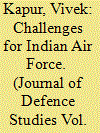

|
|
|
|
|
| Publication |
2013.
|
| Summary/Abstract |
This is the first in a four-article series on the theme 'IAF Deep Multidimensional Change 2032: Imperatives and a Roadmap'. It examines the challenges that the Indian Air Force (IAF) is likely to face when it completes a century in 2032. The main external challenges facing the IAF are the Chinese, Pakistani and Sino-Pak threat, and the need to build and maintain capability for Out of Area Contingency Operations. Internal threats identified fall under groups of technology, including the control of IAF's equipment, cyber warfare, issues stemming from IAF's unavoidable linkages with society at large and issues pertaining to IAF's own organizational structure and policies. The three subsequent articles will discuss the ways and means to address these challenges as well as provide recommendations towards that end.
|
|
|
|
|
|
|
|
|
|
|
|
|
|
|
|
| 2 |
ID:
115944
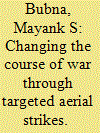

|
|
|
|
|
| Publication |
2013.
|
| Summary/Abstract |
Targeted air strikes remain a cornerstone fighting technique in modern counter-insurgency and other military operations. Yet, scholars and practitioners remain divided on the question of the efficacy of this battle mechanism. This article examines some of the underlying assumptions made in their previous analyses, and serves to nuance those approaches. Specifically, it looks at war, not as a static phenomenon but rather as a constantly evolving environment-one where such aerial campaigns affect insurgent counter-strike capabilities and decisions. Using the USled war in Afghanistan in 2008-09, the article discovers that air strikes limit non-sophisticated counterattacks but are unable to reverse a growing of sophisticated insurgent activity-a discovery that has academic and policy relevant implications.
|
|
|
|
|
|
|
|
|
|
|
|
|
|
|
|
| 3 |
ID:
115939
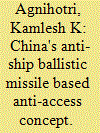

|
|
|
|
|
| Publication |
2013.
|
| Summary/Abstract |
The Chinese efforts towards actualization of the 'offshore defense' concept which entails the conduct of campaigns in distant waters, strategic deterrence and counterattacks, has an inherent risk of bringing its naval forces on a confrontational course vis-à-vis other maritime forces, particularly the US. To defend itself against overarching US maritime superiority in such a scenario, China has developed its Anti-access and Area Denial (A2AD) concept, predicated mainly around the DF-21D anti-ship ballistic missile. The inherently defensive Anti-access concept against the US in the western Pacific has the potential to transform into an offensive option for the northern Indian Ocean, should it undergo a southward reorientation. Situational assessment of such a possibility would provide an insight into the technological challenges which could be posed to the security of the resident northern Indian Ocean littorals. The possibility of such a challenge emerging in future should catalyse a vigorous maritime cooperative endeavour between commonly affected parties operating in the region.
|
|
|
|
|
|
|
|
|
|
|
|
|
|
|
|
| 4 |
ID:
115945
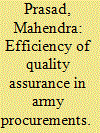

|
|
|
|
|
| Publication |
2013.
|
| Summary/Abstract |
This article gives an overview of the evolution of Quality Assurance (QA) in army procurements as also various shortcomings in the contemporary principles and practices that cause delays in procurements and their possible solutions. The list of shortcomings is not exhaustive; however, due care has been taken to bring out the most important ones which need immediate attention. The causal factors of these shortcomings have been analysed and recommendations to overcome them have also been listed to make the QA practice more efficient and minimize delays due to QA.
Few people have the wisdom to prefer the criticism that would do them good, to the praise that deceives them.
|
|
|
|
|
|
|
|
|
|
|
|
|
|
|
|
| 5 |
ID:
115952


|
|
|
|
|
| Publication |
2013.
|
| Summary/Abstract |
This commentary attempts to map out some of the salient options for India in the region east of the Indian Ocean, that is, from the South China Sea (SCS) extending to the South Pacific. A maritime debate, the role and function of the Indian Navy is thus central. Located at the gateway between the Indian Ocean Region (IOR) and the Pacific, the SCS 'is not only a strategic maritime link between the Pacific and the Indian Oceans, but also a vital gateway for shipping in East Asia.'1 Attention needs to be paid to these vital links as they are the sinews that support the trade and exchange which has propelled the Asian economic boom. India's interests in this region run up against China's assertive political claims over the same. Here, I attempt to draw out some possibilities that can facilitate smoother, successful options for the pursuit and achievement of Indian interests in the future.
|
|
|
|
|
|
|
|
|
|
|
|
|
|
|
|
| 6 |
ID:
115938
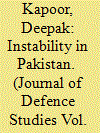

|
|
|
|
|
| Publication |
2013.
|
| Summary/Abstract |
What is happening in Pakistan today is no secret. It is a country ruled by a shaky coalition of political parties led by the Pakistan Peoples Party (PPP). The government and judiciary are on a collision course with one Prime Minister (Yousuf Raza Gillani) having had to resign. The Army, the force behind every major decision in Pakistan, is zealously guarding its turf and dominant position in the polity, irrespective of who heads the government and unmindful of the ultimate consequences. The economy of the country is in shambles, thanks to short-sighted policies, excessively disproportionate spending on military, and an elitist approach towards governance. Even nature has played its part in the form of earthquakes and floods in pulling the economy down.
|
|
|
|
|
|
|
|
|
|
|
|
|
|
|
|
| 7 |
ID:
115951
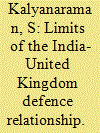

|
|
|
|
|
| Publication |
2013.
|
| Summary/Abstract |
The United Kingdom (UK) is keen on establishing a 'stronger, wider and deeper' relationship with India. It is 'determined to make' defence cooperation 'an essential part' of this relationship. London sees such a relationship with an India that will shape the twenty-first century as 'an essential pillar' in its 'broader strategy' to fashion a role for itself in Asia.
But how important is the UK for India's role in the emerging Asian landscape? Not very, it appears, from de rigueur statements about sharing 'the same vision for a renewed and enhanced partnership' and working together to address 'the challenges of global poverty and development, reform of global institutions, terrorism and climate change' as well as from appeals for a 'better appreciation of each other's core concerns including on the security environment' and particularly the challenge of terrorism.
|
|
|
|
|
|
|
|
|
|
|
|
|
|
|
|
| 8 |
ID:
115947
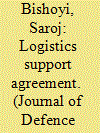

|
|
|
|
|
| Publication |
2013.
|
| Summary/Abstract |
Logistics support between the armed forces of India and the US will be a vital aspect for enhancing cooperation in capability development to respond to natural disasters and address emerging security threats of the twenty-first century. As the 2005 India-US New Framework Defence Agreement highlights the broader areas of convergence of security interests, the exchange of logistics support facilities would further enhance bilateral defence cooperation as well as India's strategic role, keeping in view the projected expansion of the Indian Navy's role beyond the Indian Ocean Region (IOR). The absence of appropriate logistics support mechanism between the two countries would hamper such capabilities to effectively deal with the security challenges during emergency situations. This article argues that the logistics support agreement the US has signed with many other countries and a similar agreement that it had proposed for India, is a mutually beneficial agreement. However, both sides need to make efforts to arrive at a consensus that is consistent with their national interests and policies.
|
|
|
|
|
|
|
|
|
|
|
|
|
|
|
|
| 9 |
ID:
115941
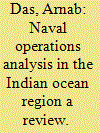

|
|
|
|
|
| Publication |
2013.
|
| Summary/Abstract |
The end of the Cold War resulted in a fundamental swing from a navy designed to engage a blue water battle fleet to one focused on forward operations in littoral waters. The Cold War era had fuelled massive research and development (R&D) in design of sonars that was able to substantially minimize the uncertainties of the underwater environment. The shift of the naval theatre to the littoral waters led to a paradigm change in terms of technology requirements to retain the effectiveness of these sonars. The underwater environment in littoral waters is significantly influenced by the local conditions and is known to be site specific. The Indian Ocean Region (IOR) is even more challenging as the shallow waters are compounded by tropical conditions. This article identifies gaps in sonar technology contributing to their ineffectiveness and presents a naval operations analysis strategy to significantly improve their performance in the IOR.
|
|
|
|
|
|
|
|
|
|
|
|
|
|
|
|
| 10 |
ID:
115948


|
|
|
|
|
| Publication |
2013.
|
| Summary/Abstract |
The phenomenon of nuclear terrorism has been the subject of intense debate as also much hype. This article seeks to cut through the hype and examine the real portents of the threat in terms of event possibilities. In doing so, it calls for sobriety and balance in discussion, emphasizes the need to guard against ignoring numerous scientific facts and real difficulties along the way, and cautions against embracing unduly alarmist overtones. It further emphasizes the need to be resolute with regard to incident occurrence because the potential consequences of a nuclear terrorist attack are so devastating as to outweigh the very low probability of event occurrence.
If current approaches towards eliminating the threat of nuclear terrorism are not replaced with a sense of urgency and resolve, the question will become not if, but when, and on what scale the first act of nuclear terrorism occurs.
-Extracted from the US-Russia Joint Threat Assessment on Nuclear Terrorism, May 2011
|
|
|
|
|
|
|
|
|
|
|
|
|
|
|
|
| 11 |
ID:
115949
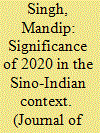

|
|
|
|
|
| Publication |
2013.
|
| Summary/Abstract |
The article looks at the implications of Hu Jintao's speech at the 18th Party Congress regarding the People's Liberation Army's (PLA) military modernization programme and analyses the significance of 2020 as a key timeline in the speech. Drawing from the previous biennial National Defense papers and significant statements of the Chinese leadership, it assesses the modernization plan of the PLA's four services in the Sino- Indian context and the probable capabilities that each service is likely will develop by 2020. The analysis covers the training, education, logistics and development of weapons and equipment by the PLA. This would enable Indian planners to assess the PLA capabilities and capacity as also temper own modernization plans to deter a possible China threat by 2020.
|
|
|
|
|
|
|
|
|
|
|
|
|
|
|
|
| 12 |
ID:
115950
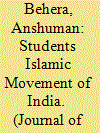

|
|
|
|
|
| Publication |
2013.
|
| Summary/Abstract |
The Students Islamic Movement of India (SIMI) continues to pose serious threats to the national security of India. Despite having been banned for 12 years, SIMI, it has been alleged, works through radical outfits like the Popular Front of India (PFI) and its front organizations. It has also been charged with having links with terror outfits such as the Lashkar-e-Taiba (LeT), Harkat-ul-Jihad-al Islami Bangladesh (HuJI-B), and the Islami Chhatra Shibir (ICS) of Bangladesh. At the same time, the government's decision to ban SIMI has been questioned by one section of its members. It is thus necessary to examine issues such as the factors leading to the formation of SIMI and its radicalization, whether SIMI as an organization can exist peacefully, in order to better understand and analyse the ways and means of dealing with it.
|
|
|
|
|
|
|
|
|
|
|
|
|
|
|
|
| 13 |
ID:
115940


|
|
|
|
|
| Publication |
2013.
|
| Summary/Abstract |
The need for credible surveillance over the high seas forms the bedrock and foundation of infallible maritime security, and Maritime Reconnaissance (MR) is the basic input for any successful maritime operation. For the last two decades, Indian naval aviation assets have been dependant on the Ilyushin (IL), the Tuplov (TU) aircraft, the Kamov (KM) 31 and Unmanned Aerial Vehicles (UAVs). The Fleet Air Defence has also received a fillip by the induction of the MIG 29Ks. At the same time, the need for Long Range Maritime Reconnaissance (LRMR) tasking has taken a giant leap forward with the Indian Ocean becoming a common operational ground and a global common for numerous navies. The Indian Navy is looking ahead to work out an asset acquisition plan commensurate with the myriad challenges envisaged in providing maritime security to the nation. This article discusses these acquisitions and showcases their contribution in the broader context of the Navy's maritime strategic aim towards provision of maritime security.
|
|
|
|
|
|
|
|
|
|
|
|
|
|
|
|
|
|
|
|
|